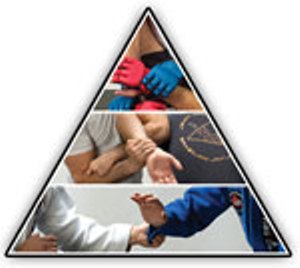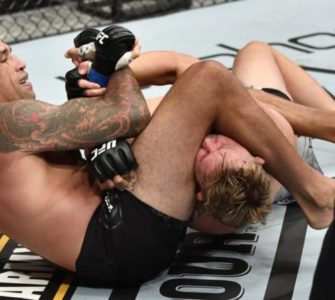
BJJ Legend Jean Jacques Machado wrote this very interesting article on the order that should be followed in learning Gi, No Gi and MMA techniques.
Source: Black Belt Mag
The Base of the Pyramid, the Gi:
From a technical standpoint, Brazilian jiu-jitsu serves as the foundation for submission grappling in general because the gi allows for the largest volume of techniques. Not only does the student of BJJ techniques have nearly limitless options at his disposal, but also he has to learn how to defend against an opponent who is intent on controlling him using the same grips. This makes for slower, more methodical matches.
As a result, a BJJ techniques practitioner has to use patience, timing and momentum as part of the overall strategy. To someone new to submission grappling, this is an accepted part of the learning process simply because the student has nothing to base his experiences on.
However, this can be a frustrating time for an experienced grappler who is new to training with the gi because the pacing of BJJ techniques is decreased, the training is more methodical, and the grappler has to worry about defensive and offensive positions that they never had to before. The gi creates new challenges for the practitioner that forces a modification in their approach to submission grappling.
The Middle of the Pyramid: Submission Grappling
Submission grappling is in the middle of the pyramid because its technical palette is smaller than jiu-jitsu’s. Unlike the world of BJJ techniques, there is no gi — so there aren’t as many offensive and defensive techniques available. Without the handles to hold onto as in BJJ techniques, numerous means of control and submission are gone and the game becomes much faster.
Competitors can move with greater ease and speed than some of their colleagues in the BJJ techniques arena. And when you factor in sweat, controlling a match with position becomes even more difficult.
Speed also can inhibit the practitioner’s vision when executing techniques. Imagine driving a car down a city street going approximately 30 miles per hour. At that speed, you can see every street sign, every exit and every option available to you.
Now imagine going down the same street at 80 mph. At that speed, your options are limited because your vision is limited. You need to stay in control of your driving and taking your eyes off the road can be disastrous. There will be options, but not as many if you were driving slower.
Where Submission Grappling Becomes Easier Without a Gi
While it would appear that everything in the submission-grappling game is more difficult without a gi, there are elements that become easier. The first is the ability to perform choking techniques.
During the course of BJJ techniques, certain arm chokes can be difficult to perform because the collar inhibits your ability to securely wrap your arms around an opponent’s neck.
In submission grappling, there is no fabric to interfere with your execution, and chokes are even easier to apply if your opponent is sweaty. With little friction and virtually zero space between your limbs and your opponent’s body, your attacks occur quickly, which make them difficult to defend against.
Another element of submission grappling that becomes easier is the ability to perform leg locks. One of the most important aspects of ground work is the ability to control the posture of the person on top. With no gi to hold onto as one would in BJJ techniques, this becomes more of a challenge.
If an opponent can move with greater freedom, the legs become vulnerable to attack. As a result, leg locks make up a large part of the submission-grappling arsenal.
The Top of the Pyramid: MMA Techniques
The top of the pyramid is mixed martial arts because striking further limits the number of submission-grappling techniques available. There are two reasons for this.
The first is that certain techniques can only be applied safely in a sportive environment. Although they have a high percentage for success, the techniques can leave you vulnerable to strikes. Also, because striking is now an option, it can be an easier and safer route to achieving victory.
For example, if you have attained the mount position on your opponent, why risk going for an arm lock or other submission? The penalty for failure can be steep. Your safest bet is to simply rain strikes down on your opponent. You have a dominant position, and if he cannot defend himself, he will either tap out or the referee will stop the match.
















